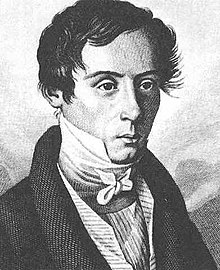Augustin-Jean Fresnel (UK: /ˈfreɪnɛl/ FRAY-nəl, US: /freɪˈnɛl/ fray-NEL;[1] French: [oɡystɛ̃ʒɑ̃ fʁɛnɛl]; 10 May 1788 – 14 July 1827) was a French civil engineer and physicist whose research in optics led to the almost unanimous acceptance of the wave theory of light, excluding any remnant of Newton's corpuscular theory, from the late 1830s [2] until the end of the 19th century.
But he is perhaps better known for inventing the catadioptric (reflective/refractive) Fresnel lens and for pioneering the use of "stepped" lenses to extend the visibility of lighthouses, saving countless lives at sea. The simpler dioptric (purely refractive) stepped lens, first proposed by Count Buffon [3] and independently reinvented by Fresnel, is used in screen magnifiers and in condenser lenses for overhead projectors.
By expressing Huygens' principle of secondary waves and Young's principle of interference in quantitative terms, and supposing that simple colors consist of sinusoidal waves, Fresnel gave the first satisfactory explanation of diffraction by straight edges, including the first satisfactory wave-based explanation of rectilinear propagation.[4] Part of his argument was a proof that the addition of sinusoidal functions of the same frequency but different phases is analogous to the addition of forces with different directions. By further supposing that light waves are purely transverse, Fresnel explained the nature of polarization and lack thereof, the mechanism of chromatic polarization (the colors produced when polarized light is passed through a slice of doubly-refractive crystal followed by a second polarizer), and the transmission and reflection coefficients at the interface between two transparent isotropic media (including Brewster's angle). Then, by generalizing the direction-speed-polarization relation for calcite, he accounted for the directions and polarizations of the refracted rays in doubly-refractive crystals of the biaxial class (those for which Huygens' secondary wavefronts are not axisymmetric). The period between the first publication of his pure-transverse-wave hypothesis and the submission of his first correct solution to the biaxial problem was less than a year. Later, he coined the terms linear polarization, circular polarization, and elliptical polarization, explained how optical rotation could be understood as a difference in propagation speeds for the two directions of circular polarization, and (by allowing the reflection coefficient to be complex) accounted for the change in polarization due to total internal reflection, as exploited in the Fresnel rhomb. Defenders of the established corpuscular theory could not match his quantitative explanations of so many phenomena on so few assumptions.
To continue reading click on the link below:
https://en.wikipedia.org/wiki/Augustin-Jean_Fresnel


إرسال تعليق